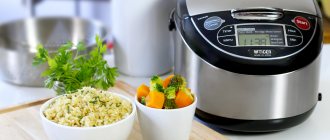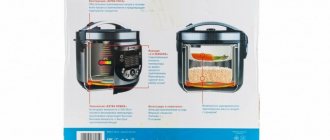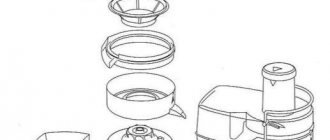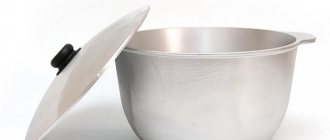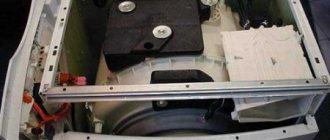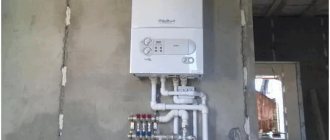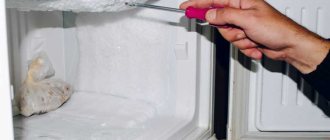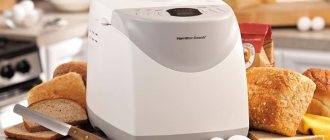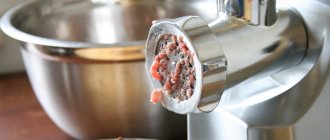When multicookers first went on sale, high hopes were placed on them. It seemed that this miracle of technology was capable of preparing a dish without human intervention, you just had to put the ingredients in a bowl and set the program. In reality, everything turned out to be a little different.
A slow cooker can save time and effort for those who figure out how to use it by reducing the amount of dirty dishes. But in order for your expectations to be met, it is important not only to handle this household appliance correctly, but also to keep it clean. How difficult is it? Let's take a closer look at how to quickly clean a multicooker.
Features of washing a multicooker
A multicooker consists of many parts . They are different in shape and materials.
Things to consider when preparing to wash your multicooker:
- Before cleaning, unplug the device. The bowl and body must cool completely.
- It is advisable to wash the multicooker bowl after each cooking. Do not store cooked food in it.
- Do not leave a dirty bowl in a closed multicooker - food particles will quickly turn sour, and it will be difficult to get rid of the unpleasant smell. It’s better to take it out and soak it in warm water if you can’t wash it right away.
- Don't forget about the moisture collector. Water must be removed from it regularly, as it can also deteriorate.
- When using the device daily, it is enough to wash it inside and out once every 10-14 days. If you cook less often, you can limit yourself to once a month.
- If something spills out of the bowl or accidentally gets onto the bottom, heating element or valve, you need to wash it off as quickly as possible before the food dries.
- Before thoroughly cleaning the device, all removable parts are disconnected.
Attention! Thoroughly dry all cleaned multicooker elements before assembling and using.
Washing Tips
To clean the multicooker lid without any effort, remember a few simple but very practical tips. They will come in handy more than once when cleaning, but will not harm the device:
- When washing, do not touch the fasteners and sealing rubber;
- It is better to start cleaning the day you use the multicooker, but you need to give it time to cool down;
- If fat has accumulated in hard-to-reach places, take a toothpick or match. Q-tips may come in handy;
- After cleaning, wipe the rubber inserts dry with a clean towel so that no traces of the cleaning agent remain on them.
The multi-cooker lid must be washed after each time you use the device. If you do not constantly take care of your multicooker, unpleasant odors and fat particles will get into your food. Spend only 5 minutes on washing, and then you will not need to wash the lid with household chemicals, and the multicooker itself will serve you for many years.
Also learn how to clean the grease inside your microwave.
Selection of detergents
It is necessary to remember which products should not be used, because they can damage the surface of the device :
- cleaning products with abrasive particles;
- dry soda;
- caustic, concentrated acid and alkaline compounds;
- aggressive grease removers;
- alcohol solvents;
- metal sponges, brushes, sponges.
If the case is not very advanced , try using hot water and a soft microfiber cloth or foam sponge. The bowl can be washed with dishwashing detergent.
For exterior surfaces that are heavily damaged by grease, use all-purpose kitchen cleaners. It is better to dilute them with water first.
Special wet wipes or entire sets consisting of wipes and a liquid product are convenient to use They will help you clean the multicooker gently and quickly.
Important! Read the instructions for the detergent you choose to avoid damaging the material from which the device parts are made.
What parts of the multicooker need to be cleaned?
Of course, first of all you need to clean those parts that come into contact with food. You will wash them after each use. In addition, the device has internal elements that also sometimes require cleaning.
| Multicooker part | Processing rules |
| Lid | It requires regular washing after each use, as condensation and grease droplets accumulate on the surface of the lid. Subsequently, the settled residues will give the new dish an unpleasant aroma and taste. |
| Bowl | Be sure to wash the bowl after each use, following the cleaning instructions depending on the material from which it is made. |
| Bottom and walls | It is especially important to monitor the condition of the bottom and walls of the device when something has “escaped” or boiled away. It is prohibited to pour liquid into the housing. Soot and food residues are removed with a suitable substance. |
| A heating element | Occasionally, but still needs cleaning, as over time carbon deposits appear on its surface. |
| Disk | It is located around the heating element and also requires cleaning from carbon deposits. |
| Valve on the lid | Steam and grease regularly accumulate here, so you need to wash the valve as often as possible. For most models it can be removed and cleaned. |
| Moisture collector | Water from the lid drains into it, which evaporates during cooking. It is enough to drain the water from the container from time to time and clean it with detergent. |
Each instruction manual for the multicooker describes the component parts in detail; if you do not find any part, look for it in the schematic drawing.
How to clean the body and lid of a multicooker
When thinking about whether it is possible to wash the multicooker completely under the tap, it is enough to remember that this is an electrical appliance that runs on mains power. Immersion of the housing in water is fraught with inevitable breakdown of household appliances. Turning it on after such a wash will create a danger to life and health.
Clean the multicooker elements correctly individually.
How to clean the case
The outer side of the housing is not directly involved in the cooking process, but drops of fat from the stove or food particles and dust can settle on it. It is better to wash them off immediately by moistening a rag or sponge with warm water.
If the grease has already dried , add a drop of dishwashing detergent to a damp sponge and foam the stains. Remove the residue with a semi-dry cloth, rinse it several times and repeat the procedure.
To remove very old stains, it is permissible to use universal kitchen sprays. Spray a small amount onto the body or use locally. Then wipe with a damp sponge several times.
the washed multicooker body dry with a soft towel.
It can be useful:
How to clean dishes from carbon deposits and old fat
How to clean burners and how to clean nozzles on a gas stove
Cleaning the glass of the oven door and between the glasses
How to clean the lid
When the lid of the device is removable , there will be no difficulties with it. Procedure:
- disconnect the lid, remove the inner disk from it and remove the steam valve;
- wash the lid with hot water and dishwashing detergent and rinse;
- wipe it thoroughly and dry it;
- clean the remaining parts;
- After all the elements have dried, assemble the cover and install it on the device.
The non-removable lid is cleaned in 2 stages:
- Pour a glass of water into the bowl, adding 2-3 slices of lemon to it. Set the “Steam” mode and turn it on for 10–15 minutes. Afterwards, drain the water and remove the bowl from the device. Wait until it cools down.
- Wrap the multicooker body in cellophane film or a bag, leaving the lid outside. Wipe the lid with a damp cloth and dishwashing detergent, rinse with a semi-dry sponge, and dry with a towel.
Advice. For convenience when washing the non-removable lid, place the multicooker on its side or tilt it forward.
Washing in certain cases
Often, for various reasons, during the operation of the device, situations arise when liquid or semi-liquid food spills out through the lid of the multicooker. In these cases, it is necessary to know in advance how to properly clean the device and how to prevent unforeseen circumstances. This usually happens when users ignore the recommendations specified in the instructions for the device, as well as:
- loading too much food into the bowl;
- the temperature is set incorrectly;
- they choose the wrong cooking process, for example, boiling instead of stewing;
- leave the device cover open.
Also, sometimes the temperature regulator in multicookers breaks down, which can also cause soup to run away or burnt porridge. In order to wipe the heating element, you can use a special brush with stiff bristles, then wipe with a sponge and a dry cloth. Do not place the multicooker under running water or rinse the device after washing to avoid damaging important parts.
All these recommendations are relevant for devices of any brand, including Redmond. After all the parts of the device have been thoroughly washed and wiped, they should be put back together, the bowl should be placed back into the multicooker, the additional accessories should be washed and put back in place. Proper and complete care of this kitchen appliance will help to extend its service life for a long time and prevent numerous breakdowns.
How to properly wash a bowl
The multicooker bowl may have a Teflon or ceramic coating. They both provide a non-stick effect and require gentle handling when cleaning.
Containers with any coating are washed as follows::
- Pour some warm water into the bottom.
- Add 1-2 drops of dishwashing detergent and leave to soak for 5-20 minutes, depending on the degree of contamination.
- Wash off the product and food particles with a foam sponge.
- Rinse well with water, wipe and dry.
Advice. If the bowl has been washed, but the smell of the dish remains, boil water with a slice of lemon in the multicooker for 10 minutes on the “Steam Boiler” mode.
The rules for cleaning the bowl are simple - no abrasives or caustic liquids. But each of the two materials will have to be given special attention.
Teflon bowl
To preserve the properties of the Teflon coating, protect it from scratches. Do not try to clean the surface of the bowl with hard sponges, scrape dried-on food with metal objects, or rub vigorously and for a long time.
If the stains are not washed off the first time , they are soaked in warm water with a mild detergent. After half an hour, dried or burnt food will easily separate from the walls.
Note! A sharp change in temperature contributes to the formation of microcracks in the Teflon coating. Do not cool a hot bowl by pouring cold water into it. Before washing, wait until the container cools down on its own. To speed up the process, remove it from the multicooker.
Ceramic bowl
The resulting chips and cracks most strongly change the properties of the ceramic coating of the bowl. Do not drop the container, place or throw heavy objects, dishes, or cutlery inside. You shouldn't rub or scrape ceramics either.
A container cleaned with soda or powder may lose its non-stick properties Even the softest abrasives will leave microcracks on the surface.
Rules of care
In a store, when choosing a kitchen assistant, customers focus on functionality, brand reliability and price of the product. Few people are interested in how to wash the inside of a multicooker.
But having already prepared their first dish, many women do not know how to properly clean the appliance. There are also those who use a dishwasher for these purposes, although manufacturers categorically do not recommend this.
During operation, the bowl becomes the most contaminated, since it is the bowl that comes into contact with food. The quality of prepared dishes depends on the cleanliness and integrity of this container, so special attention must be paid to its care. The first cleaning of the bowl should be carried out immediately after purchase.
Ceramic or Teflon
Teflon bowls allow you to cook any dish even without adding oil.
Teflon is very convenient to use. Food doesn't stick to it, which means you don't have to peel or rub anything. But this statement is true only for undamaged coating. Teflon is a plastic. The uniqueness of this coating lies in its slip and resistance to high temperatures (up to 260 degrees). In addition, it does not interact with acid and alkali. Unfortunately, such a coating is easily scratched and subject to mechanical damage. Even careful use will not extend the service life of the Teflon bowl for more than three years. And especially durable coatings, which are difficult to damage even with a knife, are very expensive.
When choosing a multicooker with a Teflon coating, you need to take care of special detergents. Do not use powders or abrasive gels. Hard sponges will also not work. As a result of their use, the coating of the bowl will be damaged, and in the future the food will always burn. A soft sponge and a kitchen balm or gel containing delicate cleaning agents will help you clean the inside of the multicooker.
Many housewives prefer ceramic bowls because they consider them more environmentally friendly. Indeed, ceramics, unlike Teflon, does not contain harmful substances, and its heat resistance is much higher and amounts to 450 degrees.
This material also has disadvantages. Kitchen appliances most often use budget ceramic coating, which will not last even a year and a half. And the cost of expensive coverage is so high that not every family can afford it.
An alkaline environment can damage the ceramic coating, so you should never wash such a bowl in the dishwasher. You only need to select soft, alkali-free products. During cleaning, you need to make sure that the bowl does not slip out of wet hands, since when dropped it quickly becomes covered with cracks and chips.
A ceramic bowl, like a Teflon bowl, can only be washed after it has completely cooled down. Temperature differences can damage the protective layer. The multicooker must be disconnected from the power supply and only then remove its elements for cleaning.
Food burnt to the walls
It is important to ensure that food does not burn. This will keep the bowl in working condition longer. You can avoid burning if you follow some important rules:
- Set the temperature according to the instructions.
- Do not exceed the permissible volume of products.
- Clean the valves in a timely manner.
- Wash off food residues after each preparation.
If the dish is still burnt, you can clean the inside of the multicooker without damaging its coating. Hard sponges or metal brushes are not suitable for this purpose. You need to take a cloth or sponge.
To remove burnt food, you need to pour a good quality dish gel and some warm water into the bowl. The container should be left for several hours. Then you should carefully remove the dirt without pressing and rinse the bowl under running water.
Cleaning the cover
The lid of the multicooker also needs to be cleaned because food residues often stick to it.
It is most convenient to wash the multicooker lid if it is removable. It is carefully disconnected and thoroughly washed with dishwashing detergent. Then it must be dried thoroughly and only then installed in place. Some models have a non-removable cover. It is much more difficult to wash it off. This cover is cleaned in two stages. First, pour a glass of water into the bowl and turn on the steam mode for 15 minutes. This helps clean away carbon deposits and dried-on food.
Then, when the multicooker has cooled down, you should wrap its body in a bag or cling film and open the lid. By carefully tilting the multicooker, you can wash the lid. But this must be done carefully so as not to wet the body.
Cleaning the body
The outside of the multicooker can remain clean for a long time. But sooner or later you will have to wash it too. This can be done using a soft cloth and soap solution. During cleaning, you must ensure that moisture does not get inside the device.
If water gets into the case, you need to dry it with a hairdryer. After this, it is not recommended to use the multicooker for three to four days. You can't plug it into an outlet either. After cleaning, it is important to ensure that no moisture remains on the heating element, otherwise mold may grow there.
Cleaning the inside of the multicooker
During use, crumbs and pieces of food accumulate on the bottom of the multicooker, and the inner walls may become covered with drops of fat.
If there is no significant contamination inside the device , remove the accumulated debris with a dampened cloth and wipe the walls, and then dry the surface.
When fat or food gets inside , try to remove it in the following ways:
- Dilute 1 tsp. baking soda in a glass of water and treat dirty areas with a cloth soaked in the solution. Wipe the surface with a damp cloth using clean water. Dry the multicooker.
- Apply lemon juice to stains or wipe them with a lemon wedge. Remove any traces of lemon with a soft damp cloth, then dry the surface.
- Locally cover the contaminated areas with dish detergent foam, then collect it with a napkin along with the dirt, and wipe the surface with a dry towel.
Smell in the slow cooker
Considering that both first and second courses, which may contain fish, as well as sweet desserts, are prepared in a multicooker, sometimes the housewife may be faced with the task of how to get rid of the smell in the multicooker. It is worth noting that there are appropriate methods to eliminate odors from different types of dishes:
- The smell of seafood. Ordinary table vinegar copes well with the fishy smell. To do this, fill the bowl with 1.5 liters of water and add a couple of full spoons of vinegar. After this, the multicooker mode must be set to o, and then thoroughly rinse the bowl under the tap with a cleaning agent, and then wipe the inner walls of the device with a clean napkin.
- Smell of plastic. To eliminate this aroma, you need to dissolve a large spoon of citric acid in a liter of water, or squeeze out half a lemon. Next, turn on the device in “steam” mode, after which it is thoroughly wiped with a damp, clean cloth.
- Strong aromas. To remove strong odors, you can use coffee beans, which perfectly absorb odors around them. To do this, place a small amount of chopped grains inside the multicooker and, without turning it on, leave it overnight.
- Strong odors. For this case, you should mix water, table salt and baking soda in equal parts. Treat the entire surface of the multicooker with the resulting solution.
People's lifehack! To remove the smell, you can boil finely chopped celery or ginger in a slow cooker. After the procedure, all that remains is to thoroughly wipe the inner surface with a damp, clean cloth.
Cleaning the heating element
It is important to know how to clean the heating element in a multicooker, because dirt immediately sticks to it. You can wash it using the same methods as the inner surface of the device .
If the suggested recipes do not help, try this::
- lightly moisten the stains with a sponge;
- sprinkle with soda;
- after 10 minutes, clean the burnt dirt;
- Remove any remaining product with a damp cloth and then wipe dry.
Important! All sponges, rags and wipes used must be semi-dry. Water ingress into the heating element is unacceptable.
How to clean a steam valve
Contaminants can also get into the steam valve. This part is important not only for removing steam, but also for maintaining the necessary pressure during cooking.
Blocked valve holes will lead to a disruption in the cooking program, food may escape, and the appliance will have to work in increased mode.
The valve, disconnected from the lid , is washed under running hot water. If grease gets on it, just clean it with a sponge and dish soap.
Note! Many steam valves have removable rubber seals, but there are also non-removable models. If you apply force when trying to remove it, the valve elements can be stretched or torn. If you were unable to disassemble the part on the first try, it is better to wash it in assembled form.
